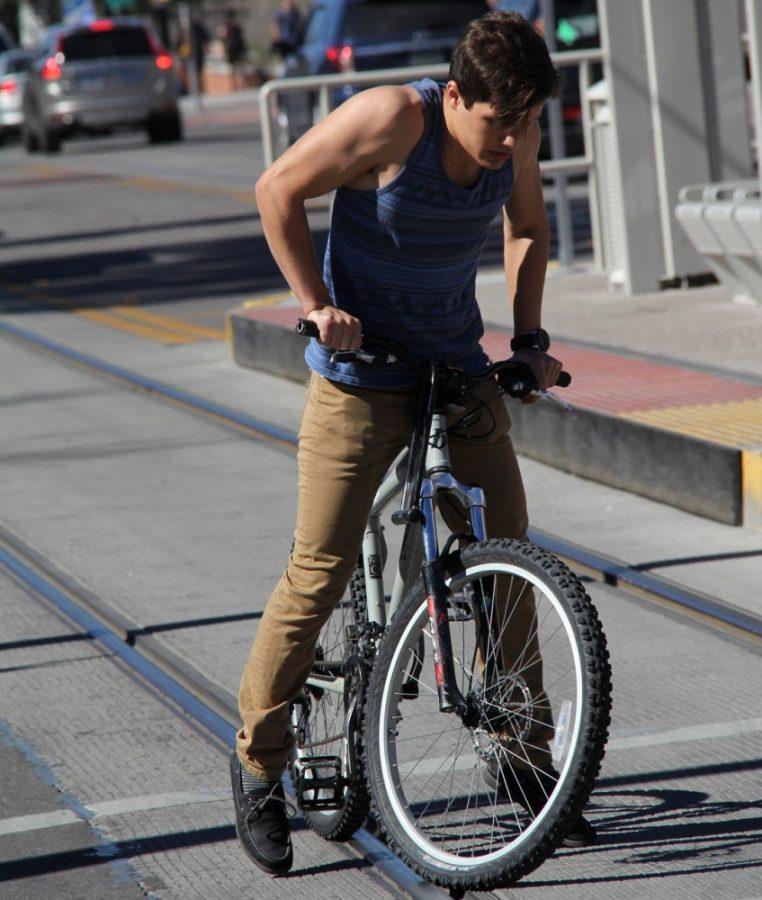Tucson’s Pedestrian Advisory Committee first convened September 2013 to address issues surrounding pedestrian injuries sustained on local roadways and to make city streets safer.
On Oct. 15, 2014, Tucson News Now reported the committee “discussed asking the city to include pedestrians in a traffic diversion program, which would give pedestrians the option to reduce their fine or waive their citation like motorists can.”
These proposed diversion classes would focus on educating Tucson’s pedestrian population. At the time of the report, PAC could not be reached for comment.
Katie Gerdts, an anthropology freshman from Long Beach, Calif., said she loves Tucson’s college-town atmosphere and culture.
Gerdts has lived just off-campus while attending the UA, and getting used to Tucson traffic norms has been odd due to some local differences, she said.
Providing pedestrians who violate traffic laws an optional educational class could quell the issue, Gerdts said.
“I think that’s a good idea, personally, because I feel like jaywalking is a really big problem here,” she said. “I think just having some better general awareness of how cars are going to react to you would be really helpful.”
On Feb. 4, the University of Arizona Police Department announced it received three separate grants from the Governor’s Office of Highway Safety, which totaled $51,198.
These grants were awarded to fund three UAPD programs:
• Officer deployment and supplies for enforcing DUI laws and reduce underage alcohol consumption
• The purchase of a new radar monitoring display center that will gage motorists’ speed navigating the campus, which will increase UA safety
• And, increase police officer presence during peak pedestrian and cyclist hours for traffic law enforcement, as well as education
Additionally, some of the grant money was allocated to fund the distribution of reflective wrist straps to students in order to boost pedestrian safety, and provide free bike lights to increase cyclist compliance with mandatory city laws.
Filbert Barrera, UAPD public information officer, said the department will be handing out approximately 200 bike lights to students who may need them.
Although Barrera is unfamiliar with PAC proposal, he said any diversion class offered to pedestrians who have been cited needs to be comprehensive and provide appropriate cost benefits to attendees.
Barrera said statutes for pedestrian citations are written as safety measures, and officers enforcing these laws often consider how traffic has been affected.
Furthermore, everyone plays a role in traffic flow on UA’s campus, and safety is easier to maintain when pedestrians keep the drivers’ perspectives in mind, he added.
“I think that there’s a misconception that, ‘Well, I’m in a crosswalk; I can just go,’” Barrera said, “and that’s not true.”
Gerdts has adjusted to being a part of university foot traffic standards, has not been cited or warned about pedestrian violations, and said she feels cars are commanding far better control on UA’s campus streets.
“I’ve never had an issue with it,” Gerdts said, “but I feel like the pedestrians are much worse about it than the cars are.”
According to the Arizona Department of Transportation, in 2013, there were 158 pedestrian fatalities and 1,356 injuries state-wide. Almost 89 percent of these incidents occurred within densely populated urban centers such as the UA campus.
On Monday, Sean Connolly, a pre-business sophomore, received a warning from UAPD. Connolly began crossing a campus street late, pushed the pedestrian signal too far and was subsequently stopped by a UA officer.
Given the option, Connolly would forego a pedestrian diversion class simply because reducing the fine is not worth the time, he said.
“I don’t think that would be appropriate for a jaywalking violation,” Connolly said. “I think that’s a little over-the-top.”
Conversely, for someone who is not from the area, Gerdts said she believes pedestrian diversion classes would be an optimal option.
“Since Tucson has some different policies, I feel like that would be a really good idea,” she said.
_______________
Follow David Joseph Del Grande on Twitter.









